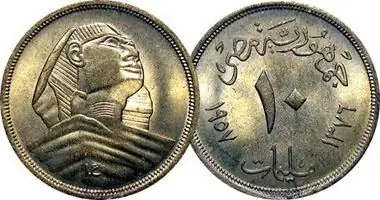2025 Author: Howard Calhoun | [email protected]. Last modified: 2025-01-24 13:10:45
Hungary is one of the few countries in Europe that, after joining the European Union, has not changed its national currency to the euro. In the article we will get acquainted with the coins of Hungary, which first appeared in circulation after the Second World War. To overcome the difficult post-war years for the people, the government decides to replace penge, old money, with new ones - forints and fillers.
Small pennies have been minted since 1892. For many years they were considered a hundredth of all paper bills.
The first coins of Hungary were created at the end of the summer of 1946. They were made from alloys of copper, brass, zinc, but some were also made of aluminum. Only a coin of 5 forints was made of silver, and then not for long. In order to save money, a year later it was replaced with an analogue from an alloy. Later, 5, 10, 20 and 50 forints were issued in aluminum. Only in 1948 was a 5 filler coin added.
HP Coins
In the Hungarian People's Republic, until the end of the eighties, there were coins in use, which you can see in the photo below. One forint was equal to one hundred pennies. Since 1949, the name of the country on the coins has been replaced by the inscription MagyarNépköztársaság, which in Hungarian meant the new name of the state.

First, the coat of arms of Kossuth was depicted on the coins of Hungary. Then it was replaced with the coat of arms of Rakosi. But since 1957, the symbol of the country has been transformed again. On this occasion, metal money was again remade.
The image did not change until 1989. Due to inflation, the smallest 1 filler coin was abolished, and two had a round hole in the middle. This is done so that in stores they do not confuse it with 20 forints, which were very similar both in size and in the color of the alloy.
Modern coins of Hungary
In recent years, the country experienced frequent crises, money depreciated, and the government decided to withdraw some coins from circulation. First, the smallest ones - fillers - stopped being produced. Although it is now believed that 1 forint is equal to 100 fillers, in fact they have not been used for many years.
Since March 2008, small coins such as 1 and 2 forints have gradually been phased out. They had a high production cost, but their denomination was very low. In order to save money, they stopped producing them.

Also, there were changes in the replacement of 200 forints, which were previously issued in paper, with metal in 2009. The famous chain bridge of Count Szechenyi is depicted on the coin.
Since 2012, the name of the state on all coins has also changed. Now, after the adoption of the new Constitution, this country is called not Hungarianrepublic, but simply Hungary (Magyarország).
An iris plant is painted on 20 forints, a coat of arms on 10 and 100 forints, an eagle on 50 forints, a heron on 5 forints.
Interesting facts
After the 1 forint coins were withdrawn from circulation, they appeared in large numbers in Canada. Enterprising residents saw a strong resemblance between the forint and their slot machine coins.
This substitution has reached such proportions that the country had to replace automatic machines with analogues of a new model.

But not only Canadians were enterprising. Residents of the UK also found similarities between their 50 pence and the Hungarian forint coin of the same denomination. Sometimes employees of retail outlets found other people's money in vending machines. But fortunately, this phenomenon has not acquired such a scope here. The question of replacing all the machines never arose.
Recommended:
Coins of the Soviet Union and modern Russia: what metal are coins made of, their features and varieties

The production of money on the territory of our country at all times was associated with a number of difficulties: the economy either developed or collapsed sharply, dragging faith in the Russian currency to the bottom, giving rise to massive disbelief in it and inflation. Now we have clear state standards for production and minting, all reforms are taking place gradually and accurately, but during the times of revolutions, civil and world wars, the question of what metal coins are made of in our country faded into the background
Change coins: history, meaning, modernity. Small change coins from different countries

A small change is needed in any state, in any city where strict payments are made between people: for the purchase of food and other necessary goods, for the services received. In different countries, small change coins are very different from each other, it depends on the official currency. Let's find out what change money we need if we go on a trip abroad
Banknotes and coins of Egypt: history and modernity. How not to make a mistake in exchanging money in Egypt?

Going on vacation or on a business trip to Egypt, many are interested in the issue of its national currency. Our article will help you figure out what kind of money is in use in this Arab country, talk about banknotes and coins, and also take a short digression into the history of the Egyptian currency
Coins of Japan: history and modernity, commemorative coins

The first coins in the Land of the Rising Sun were brought from a neighboring state. Find out how the monetary system of Japan developed and what coins operate in the country now
Hungarian forint: an excursion from the past to the present

The Hungarian forint is a currency with an interesting history that has become the main tool for initiating a political upheaval. The currency exchange rate remains more or less stable today

